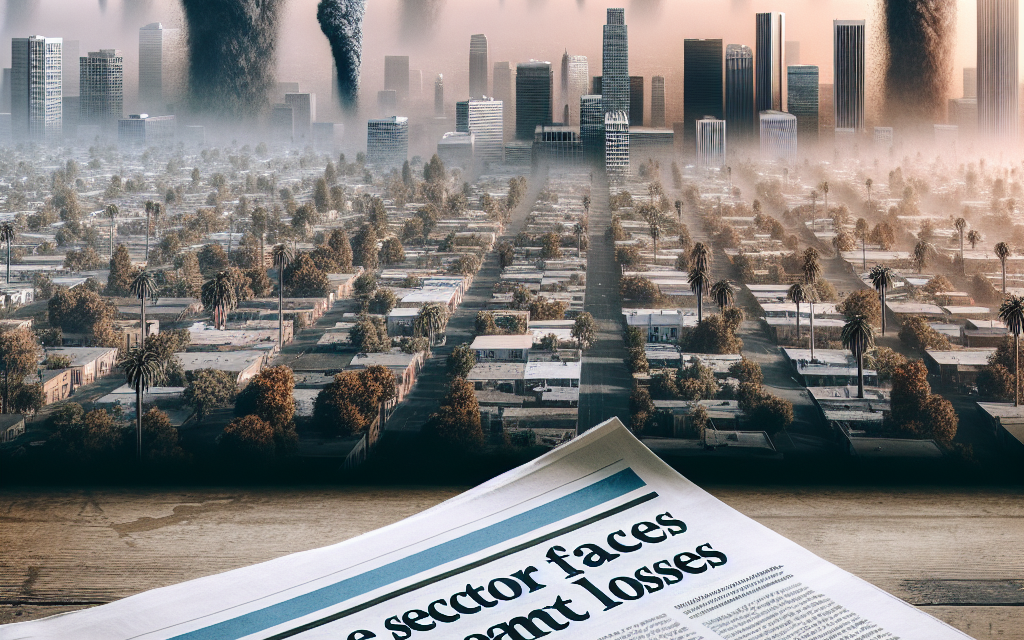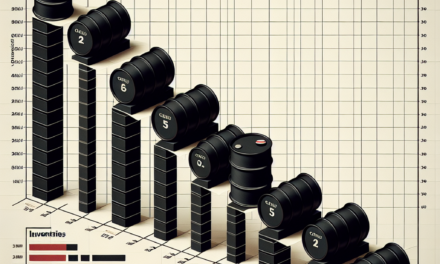“Insurance Sector Reels as Los Angeles Wildfires Ignite Unprecedented Losses.”
Introduction
The insurance sector is grappling with unprecedented losses following the devastating wildfires that swept through Los Angeles, causing widespread destruction and displacing thousands of residents. As flames engulfed homes, businesses, and natural landscapes, insurers are now faced with the daunting task of assessing damages that could reach into the billions. The scale and intensity of these wildfires have not only strained the financial resources of insurance companies but also raised concerns about the long-term sustainability of coverage in high-risk areas. With climate change exacerbating the frequency and severity of such disasters, the industry is at a critical juncture, prompting discussions on policy adjustments, risk management strategies, and the future of insurance in wildfire-prone regions.
Impact of Los Angeles Wildfires on Insurance Premiums
The recent wildfires in Los Angeles have not only devastated communities and ecosystems but have also sent shockwaves through the insurance sector, leading to unprecedented losses that are likely to reshape the landscape of insurance premiums in the region. As the flames ravaged homes and businesses, the financial repercussions for insurance companies became increasingly apparent. The immediate aftermath of such disasters typically involves a surge in claims, which can strain the resources of insurers and lead to significant financial liabilities. Consequently, this situation compels insurers to reassess their risk models and pricing strategies, ultimately impacting policyholders.
In the wake of the wildfires, insurance companies are faced with the daunting task of evaluating the extent of the damage. The sheer scale of destruction necessitates a comprehensive assessment of claims, which can take months or even years to finalize. As insurers grapple with these challenges, they must also consider the long-term implications of climate change and its role in exacerbating the frequency and intensity of wildfires. This evolving understanding of risk is likely to lead to a recalibration of premiums, as insurers seek to align their pricing with the heightened threat posed by such natural disasters.
Moreover, the financial strain caused by the wildfires may prompt insurers to adopt more stringent underwriting practices. This could manifest in increased premiums for existing policyholders, as well as a more cautious approach to new policy issuance in high-risk areas. As a result, individuals and businesses in Los Angeles may find themselves facing higher costs for coverage, which could further complicate their ability to recover from the devastation. The potential for rising premiums raises concerns about affordability, particularly for low- and middle-income families who may already be struggling to make ends meet.
In addition to the direct impact on premiums, the wildfires may also lead to a broader shift in the insurance market. Insurers may begin to withdraw from high-risk areas altogether, limiting access to coverage for those living in fire-prone regions. This trend could create a significant gap in the market, leaving many residents without adequate protection against future disasters. As insurers reevaluate their risk exposure, the possibility of a “coverage desert” looms large, where individuals are unable to secure necessary insurance, thereby increasing their vulnerability to financial ruin in the event of another catastrophic event.
Furthermore, the implications of these changes extend beyond individual policyholders. The ripple effects on the economy could be profound, as businesses may struggle to obtain affordable coverage, leading to increased operational costs and potential layoffs. This scenario could stifle economic growth in the region, as companies may be forced to scale back or even close their doors due to the financial burden of rising insurance premiums.
In conclusion, the impact of the Los Angeles wildfires on insurance premiums is multifaceted and far-reaching. As insurers confront unprecedented losses, the likelihood of increased premiums and stricter underwriting practices becomes more pronounced. This evolving landscape not only affects individual policyholders but also poses significant challenges for the broader economy. As the insurance sector navigates this new reality, it will be crucial for stakeholders to engage in proactive discussions about risk management, affordability, and access to coverage, ensuring that communities can recover and rebuild in the face of future challenges.
Claims Processing Challenges Post-Wildfires
The recent wildfires in Los Angeles have not only devastated communities and landscapes but have also posed significant challenges for the insurance sector, particularly in the realm of claims processing. As the flames subsided, the focus shifted to the daunting task of assessing damages and facilitating claims for the thousands of affected policyholders. However, the scale and intensity of the destruction have created a complex environment for insurers, leading to unprecedented losses and operational hurdles.
One of the primary challenges in claims processing post-wildfires is the sheer volume of claims that insurers must handle. With thousands of homes and businesses affected, insurance companies are inundated with requests for assistance. This influx can overwhelm existing claims processing systems, which may not be equipped to manage such a rapid and extensive surge. Consequently, policyholders may experience delays in receiving the support they need, exacerbating their already stressful situations. Insurers are often forced to allocate additional resources, including hiring temporary staff and implementing overtime, to cope with the increased workload. However, even with these measures, the sheer number of claims can lead to bottlenecks, prolonging the time it takes to process each individual claim.
Moreover, the complexity of the claims themselves adds another layer of difficulty. Wildfire damage can vary significantly from one property to another, with some homes suffering total loss while others may have only sustained partial damage. This variability necessitates thorough inspections and assessments, which can be time-consuming. Adjusters must evaluate not only the physical damage but also the potential for additional living expenses and other related costs. As a result, the claims process can become protracted, leaving policyholders in a state of uncertainty regarding their financial recovery.
In addition to the logistical challenges, the emotional toll on both policyholders and claims adjusters cannot be overlooked. Many individuals who have lost their homes are grappling with grief and trauma, which can complicate their interactions with insurance representatives. Adjusters, too, face the emotional burden of witnessing the aftermath of the wildfires, which can impact their efficiency and decision-making. This human element underscores the importance of empathy and understanding in the claims process, yet it can also lead to further delays if not managed effectively.
Furthermore, the wildfires have highlighted the need for improved technology and data management within the insurance sector. Many companies are now recognizing that outdated systems can hinder their ability to respond swiftly and effectively to large-scale disasters. As a result, there is a growing emphasis on investing in advanced claims management software and data analytics tools that can streamline the process and enhance communication between insurers and policyholders. By leveraging technology, insurers can better track claims, assess damages more accurately, and ultimately expedite the resolution process.
In conclusion, the claims processing challenges following the Los Angeles wildfires illustrate the multifaceted difficulties faced by the insurance sector in times of crisis. The overwhelming volume of claims, the complexity of damage assessments, and the emotional strain on all parties involved create a perfect storm that complicates recovery efforts. As the industry grapples with these unprecedented losses, it is imperative that insurers adapt and innovate to improve their claims processing capabilities, ensuring that they can provide timely and effective support to those in need. The lessons learned from this disaster may ultimately pave the way for a more resilient and responsive insurance landscape in the future.
The Role of Climate Change in Insurance Losses
The insurance sector is currently grappling with unprecedented losses stemming from the recent wildfires in Los Angeles, a situation that underscores the profound impact of climate change on the industry. As temperatures rise and weather patterns become increasingly erratic, the frequency and intensity of wildfires have escalated, leading to significant financial repercussions for insurers. This evolving landscape necessitates a closer examination of how climate change is reshaping risk assessments and underwriting practices within the insurance sector.
To begin with, the correlation between climate change and the rise in wildfire incidents is well-documented. Warmer temperatures contribute to drier conditions, which in turn create an environment conducive to wildfires. As vegetation becomes parched, the likelihood of ignition increases, resulting in more frequent and severe fire events. Consequently, insurers are faced with a growing number of claims related to property damage, loss of life, and business interruption. The financial strain on insurance companies is exacerbated by the fact that many of these claims are for substantial amounts, reflecting the high value of properties in fire-prone areas.
Moreover, the unpredictability of climate-related events complicates the risk assessment process for insurers. Traditional models that rely on historical data to predict future losses are becoming less reliable as climate change alters the landscape of risk. Insurers are now tasked with integrating climate projections into their underwriting processes, which requires a significant shift in how they evaluate potential liabilities. This transition is not only challenging but also resource-intensive, as companies must invest in advanced modeling techniques and data analytics to better understand the evolving risks associated with climate change.
In addition to the immediate financial losses, the long-term implications of climate change on the insurance sector are equally concerning. As wildfires become more common, insurers may be compelled to raise premiums or even withdraw coverage from high-risk areas altogether. This could lead to a phenomenon known as “insurance desertification,” where residents in vulnerable regions find it increasingly difficult to obtain affordable coverage. Such a scenario not only places a burden on homeowners but also has broader implications for community resilience and recovery efforts following catastrophic events.
Furthermore, the insurance industry is under increasing pressure from regulators and stakeholders to adopt more sustainable practices. As awareness of climate change grows, there is a heightened expectation for insurers to play a proactive role in mitigating risks associated with environmental changes. This includes not only adjusting underwriting criteria but also investing in initiatives that promote resilience, such as funding for fire prevention programs and supporting community preparedness efforts. By taking these steps, insurers can help to reduce the overall impact of wildfires and other climate-related disasters, ultimately benefiting both their bottom line and the communities they serve.
In conclusion, the role of climate change in driving unprecedented losses within the insurance sector is multifaceted and complex. As wildfires in Los Angeles illustrate, the interplay between environmental factors and insurance risk is becoming increasingly pronounced. Insurers must adapt to this new reality by refining their risk assessment methodologies, embracing sustainable practices, and engaging with communities to foster resilience. By doing so, they can not only navigate the challenges posed by climate change but also contribute to a more sustainable future for all stakeholders involved.
Strategies for Insurers to Mitigate Future Risks
The recent wildfires in Los Angeles have underscored the vulnerabilities within the insurance sector, revealing the extent of financial losses that can arise from natural disasters. As insurers grapple with the aftermath of these catastrophic events, it becomes imperative to explore strategies that can mitigate future risks and enhance resilience. One of the foremost approaches involves the integration of advanced data analytics and technology into risk assessment processes. By leveraging big data, insurers can gain deeper insights into environmental factors, historical fire patterns, and property vulnerabilities. This data-driven approach enables insurers to refine their underwriting criteria, ensuring that policies are priced accurately according to the level of risk associated with specific geographical areas.
In addition to enhancing risk assessment, insurers can also invest in predictive modeling tools that simulate various wildfire scenarios. These models can help insurers anticipate potential losses and adjust their coverage offerings accordingly. By understanding the likelihood of different fire intensities and their potential impact on insured properties, insurers can develop more tailored policies that reflect the unique risks faced by homeowners and businesses in fire-prone regions. Furthermore, collaboration with meteorological agencies and environmental organizations can provide insurers with real-time data on weather conditions and fire risks, allowing for proactive measures to be taken before disasters strike.
Another critical strategy for mitigating future risks lies in fostering community resilience through partnerships with local governments and organizations. Insurers can play a pivotal role in promoting fire prevention initiatives, such as creating defensible spaces around properties and implementing community-wide fire safety programs. By investing in these initiatives, insurers not only contribute to reducing the overall risk of wildfires but also enhance their own long-term sustainability. Additionally, offering premium discounts or incentives for policyholders who engage in fire mitigation practices can encourage more homeowners to take proactive steps in safeguarding their properties.
Moreover, diversifying the insurance portfolio can serve as a buffer against catastrophic losses. Insurers should consider expanding their coverage options to include policies that address emerging risks associated with climate change, such as flooding and extreme weather events. By broadening their scope, insurers can spread risk across various sectors and geographical areas, thereby reducing their exposure to any single catastrophic event. This diversification strategy not only protects the insurer’s financial health but also provides policyholders with comprehensive coverage that reflects the evolving nature of risks.
Furthermore, enhancing communication and education efforts is essential in preparing policyholders for potential disasters. Insurers can develop resources and tools that inform homeowners about the importance of disaster preparedness, including creating emergency plans and maintaining adequate insurance coverage. By empowering policyholders with knowledge, insurers can foster a culture of preparedness that ultimately reduces the severity of claims during catastrophic events.
In conclusion, the insurance sector must adopt a multifaceted approach to mitigate future risks associated with wildfires and other natural disasters. By leveraging technology, fostering community resilience, diversifying portfolios, and enhancing communication efforts, insurers can not only protect their financial interests but also contribute to the overall safety and well-being of the communities they serve. As the frequency and intensity of wildfires continue to rise, these strategies will be crucial in ensuring that the insurance industry remains robust and capable of meeting the challenges posed by an increasingly volatile environment.
Policyholder Rights During Wildfire Claims
The recent wildfires in Los Angeles have not only devastated communities but have also placed immense pressure on the insurance sector, leading to unprecedented losses. As policyholders navigate the aftermath of these disasters, it is crucial for them to understand their rights during the claims process. This understanding can significantly impact their ability to recover and rebuild, ensuring they receive the compensation they are entitled to under their insurance policies.
First and foremost, policyholders have the right to file a claim for damages incurred as a result of the wildfires. This process begins with notifying the insurance company as soon as possible, as many policies stipulate a specific timeframe for reporting claims. It is essential for policyholders to document all damages thoroughly, including taking photographs and keeping records of any expenses incurred due to the fire. This documentation serves as vital evidence when substantiating claims and can expedite the claims process.
Moreover, policyholders have the right to receive a clear explanation of their coverage. Insurance policies can be complex, often filled with legal jargon that may be difficult to understand. Therefore, it is advisable for policyholders to request a detailed breakdown of their coverage from their insurance provider. This includes understanding the limits of their policy, any exclusions that may apply, and the process for determining the value of their losses. By gaining clarity on these aspects, policyholders can better advocate for themselves during the claims process.
In addition to understanding their coverage, policyholders have the right to appeal any claim denials or disputes regarding the amount offered by their insurance company. If a claim is denied or if the compensation offered is deemed insufficient, policyholders can formally appeal the decision. This process typically involves providing additional documentation or evidence to support their case. It is important for policyholders to remain persistent and proactive, as many claims are successfully overturned upon appeal.
Furthermore, policyholders are entitled to timely communication from their insurance providers. Insurers are obligated to keep policyholders informed about the status of their claims and any necessary steps they need to take. If there are delays or if additional information is required, policyholders should not hesitate to reach out to their insurers for updates. Maintaining open lines of communication can help alleviate some of the stress associated with the claims process and ensure that claims are processed efficiently.
Additionally, policyholders should be aware of their right to seek assistance from state regulatory agencies or consumer advocacy groups if they encounter difficulties with their insurance claims. These organizations can provide valuable resources and guidance, helping policyholders navigate the complexities of the insurance landscape. They can also intervene on behalf of policyholders in cases of unfair treatment or unethical practices by insurance companies.
In conclusion, as the insurance sector grapples with the fallout from the Los Angeles wildfires, it is imperative for policyholders to be informed about their rights during the claims process. By understanding their entitlements, documenting their losses, and advocating for fair treatment, policyholders can enhance their chances of receiving the compensation they deserve. Ultimately, this knowledge empowers individuals to rebuild their lives and communities in the wake of such devastating events.
The Economic Ripple Effect of Wildfire Losses
The recent wildfires in Los Angeles have not only devastated landscapes and communities but have also triggered significant economic repercussions that extend far beyond the immediate destruction. As the flames ravaged homes and businesses, the insurance sector found itself grappling with unprecedented losses, which in turn has created a ripple effect throughout the broader economy. The financial strain on insurance companies is likely to lead to increased premiums for policyholders, as insurers seek to recoup their losses and maintain solvency. This adjustment in pricing can place additional burdens on homeowners and businesses already struggling to recover from the physical damage caused by the fires.
Moreover, the rising insurance costs can deter potential homebuyers from entering the market, thereby stifling real estate activity in affected areas. As insurance becomes more expensive and harder to obtain, prospective buyers may reconsider their plans, leading to a slowdown in housing demand. This decline can have a cascading effect on local economies, as reduced real estate transactions can diminish revenue for local governments that rely on property taxes. Consequently, municipalities may face budget shortfalls, which could hinder their ability to provide essential services and support recovery efforts.
In addition to the real estate market, the wildfire losses have also impacted various sectors, including construction and retail. With many homes and businesses destroyed, the demand for construction services is expected to surge as rebuilding efforts commence. However, this increased demand may be tempered by a shortage of skilled labor and materials, which could drive up costs and extend project timelines. As construction companies grapple with these challenges, they may also face delays in securing necessary permits and approvals, further complicating the recovery process.
Retail businesses, particularly those in the vicinity of the wildfires, have also felt the economic strain. Many establishments were forced to close temporarily or permanently due to fire damage or loss of inventory. As these businesses struggle to recover, the local economy suffers from reduced consumer spending and job losses. The interconnectedness of these sectors highlights the broader implications of the wildfires, as the economic health of one area can significantly influence others.
Furthermore, the psychological impact of such disasters cannot be overlooked. The uncertainty and stress experienced by residents and business owners can lead to decreased consumer confidence, which in turn affects spending habits. When individuals are uncertain about their financial future, they are less likely to make significant purchases or investments, further stalling economic recovery. This hesitance can create a prolonged period of stagnation, as communities work to rebuild while simultaneously grappling with the emotional toll of the disaster.
As the insurance sector continues to navigate the aftermath of the Los Angeles wildfires, it is essential to recognize the interconnected nature of these economic challenges. The losses incurred by insurers will not only affect their bottom lines but will also reverberate through various sectors, impacting everything from housing markets to local businesses. Policymakers and community leaders must work collaboratively to address these challenges, ensuring that recovery efforts are comprehensive and sustainable. By fostering resilience in the face of such disasters, communities can better prepare for future challenges, ultimately leading to a more robust economic landscape. The lessons learned from this crisis will be invaluable as stakeholders seek to mitigate the impacts of wildfires and other natural disasters in the years to come.
Innovations in Insurance Coverage for Natural Disasters
The insurance sector is currently grappling with unprecedented losses stemming from the recent wildfires in Los Angeles, a situation that has prompted a reevaluation of existing coverage models and the development of innovative solutions tailored to natural disasters. As climate change continues to exacerbate the frequency and intensity of such catastrophic events, insurers are compelled to adapt their strategies to mitigate risks and enhance their offerings. This necessity has led to a surge in innovative insurance products designed specifically for natural disasters, reflecting a proactive approach to an increasingly volatile environment.
One of the most significant advancements in this area is the integration of technology into insurance underwriting and claims processing. Insurers are now leveraging data analytics and artificial intelligence to assess risk more accurately. By utilizing satellite imagery and real-time data, companies can better understand the geographical areas most susceptible to wildfires, floods, and other natural disasters. This enhanced risk assessment allows insurers to tailor policies that reflect the true risk profile of individual properties, thereby ensuring that coverage is both adequate and affordable. Furthermore, the use of predictive modeling enables insurers to anticipate potential losses and adjust their reserves accordingly, which is crucial in maintaining financial stability in the face of increasing claims.
In addition to improved risk assessment, the insurance industry is also exploring parametric insurance products. Unlike traditional insurance, which compensates policyholders based on the actual loss incurred, parametric insurance pays out a predetermined amount when specific conditions are met, such as a wildfire reaching a certain size or a flood exceeding a particular depth. This model not only streamlines the claims process but also provides immediate financial relief to policyholders, allowing them to recover more swiftly from disasters. As such, parametric insurance is gaining traction among businesses and homeowners alike, as it offers a more predictable and efficient means of financial protection.
Moreover, insurers are increasingly focusing on incentivizing risk mitigation measures among policyholders. By offering premium discounts for implementing fire-resistant building materials or creating defensible space around properties, insurers encourage proactive behavior that can significantly reduce the likelihood of damage during a disaster. This shift towards a more collaborative approach not only benefits policyholders but also helps insurers manage their risk exposure more effectively. As a result, the insurance sector is fostering a culture of resilience, where both insurers and insured parties work together to minimize the impact of natural disasters.
Additionally, the rise of insurtech companies has further accelerated innovation within the insurance landscape. These technology-driven firms are challenging traditional models by offering flexible, on-demand insurance solutions that cater to the unique needs of individuals and businesses in disaster-prone areas. By harnessing the power of technology, insurtechs are able to provide more personalized coverage options, making it easier for consumers to find policies that align with their specific risk profiles.
In conclusion, the unprecedented losses faced by the insurance sector due to the Los Angeles wildfires have catalyzed a wave of innovation in insurance coverage for natural disasters. Through advancements in technology, the introduction of parametric insurance, and a focus on risk mitigation, the industry is evolving to meet the challenges posed by an increasingly unpredictable climate. As these innovations continue to unfold, they hold the promise of not only enhancing the resilience of the insurance sector but also providing vital support to communities affected by natural disasters.
Q&A
1. **What caused the unprecedented losses in the insurance sector from the Los Angeles wildfires?**
The wildfires were fueled by extreme weather conditions, including prolonged drought and high winds, leading to widespread property damage.
2. **How much in losses is the insurance sector expected to incur from the wildfires?**
Estimates suggest that losses could exceed several billion dollars, significantly impacting insurers’ financial stability.
3. **Which types of insurance claims are most affected by the wildfires?**
Homeowners’ insurance claims, commercial property claims, and claims related to business interruption are among the most affected.
4. **What measures are insurers taking in response to the losses?**
Insurers are reassessing risk models, increasing premiums, and in some cases, limiting coverage in high-risk areas.
5. **How do these losses impact policyholders?**
Policyholders may face higher premiums, reduced coverage options, and potential difficulties in obtaining insurance in fire-prone areas.
6. **What role does climate change play in the frequency and severity of wildfires?**
Climate change contributes to hotter temperatures and drier conditions, increasing the likelihood and intensity of wildfires.
7. **Are there any government responses to support the insurance sector after the wildfires?**
Governments may consider disaster relief funds, regulatory adjustments, or initiatives to improve fire prevention and mitigation efforts.
Conclusion
The insurance sector is experiencing unprecedented losses due to the recent wildfires in Los Angeles, driven by the increasing frequency and intensity of such natural disasters. The financial impact is compounded by rising claims, escalating property values, and the challenges of accurately assessing risk in a changing climate. As insurers grapple with these challenges, the need for innovative risk management strategies and policy adjustments becomes critical to ensure sustainability and resilience in the face of future wildfire events.





